Vegetable Recognition and Classification Based on Improved VGG Deep Learning Network Model
 , Ling Zhu1, 2, Jun Yue4
, Ling Zhu1, 2, Jun Yue4- DOI
- 10.2991/ijcis.d.200425.001How to use a DOI?
- Keywords
- Vegetable recognition and classification; Deep learning; VGG-nets; Framework of caffe
- Abstract
To improve the accuracy of automatic recognition and classification of vegetables, this paper presents a method of recognition and classification of vegetable image based on deep learning, using the open source deep learning framework of Caffe, the improved VGG network model was used to train the vegetable image data set. We propose to combine the output feature of the first two fully connected layers (VGG-M). The Batch Normalization layers are added to the VGG-M network to improve the convergence speed and accuracy of the network (VGG-M-BN). The experimental verification, this paper method in the test data set on the classification of recognition accuracy rate as high as 96.5%, compared with VGG network (92.1%) and AlexNet network (86.3%), the accuracy rate has been greatly improved. At the same time, increasing the Batch Normalization layers make the network convergence speed nearly tripled. Improve the generalization ability of the model by expanding the scale of the training data set. Using VGG-M-BN network to train different number of vegetable image data sets, the experimental results show that the recognition accuracy decreases as the number of data sets decreases. By contrasting the activation functions, it is verified that the Rectified Linear Unit (ReLU) activation function is better than the traditional Sigmoid and Tanh functions in VGG-M-BN networks. The paper also verifies that the classification accuracy of VGG-M-BN network is improved due to the increase of batch_size.
- Copyright
- © 2020 The Authors. Published by Atlantis Press SARL.
- Open Access
- This is an open access article distributed under the CC BY-NC 4.0 license (http://creativecommons.org/licenses/by-nc/4.0/).
1. INTRODUCTION
In recent years, the development model of agriculture in China is changing from traditional agriculture to modern intelligent agriculture; the production of vegetables in agricultural products is also increasing. However, at present, vegetable picking, sorting and sales tasks still rely on manual completion, not only a large amount of labor force is consumed, but also the work efficiency is low, which seriously affecting the development of commercialization of vegetable products. The research of automatic recognition and classification [1–3] of vegetables provides important technical support to solve the above problems.
Scholar at home and broad have been devoted to fruit recognition and classification and significant progress has been made in this field. Pragati et al. [3] introduce new fruits recognition techniques. This combines four features analysis method shape, size and color, texture based method to increase accuracy of recognition. Proposed method used is nearest neighbor (NN) classification algorithm. Dubey et al. [4] extracted different state-of-art color and texture features and combined them to achieve more efficient and discriminative feature description. Multi-class support vector machine is used for the training and classification purpose. The experimental results show that this strategy combining multiple methods can achieve better recognition efficiency. Zhang et al. [5] proposed a method based on fitness-scaled chaotic artificial bee colony algorithm and feedforward neural network (FSCABC-FNN). The network extracted color, shape and texture as features. The method reached a rather good accuracy. In the meanwhile, Tao H W et al. [6] propose a method for recognition fruit and vegetable types based on color and texture features. Used a matching score fusion algorithm to fuse color and texture features, and finally, a NN classifier is used to realize fruit and vegetable recognition. As we can see, a majority of methods on fruit classification are traditional and old-fashion. Linear classifier and KNN classifier take great part in fruit classification and features are rare, which limits the development and accuracy of methods.
The concept of deep learning [7–11] originates from artificial neural networks. Deep learning forms more abstract high-level features through the combination of low-level features, which to find the distributed features of the data. In 2012, Hinton's team, known as the “father of deep learning,” won the ImageNet image classification [12–15] contest using deep learning methods. The classification accuracy was over 10% higher than the second was. The result was a huge shock in the field of computer vision; it has set off a craze for deep learning in academia. The deep learning network mainly includes Stacked AutoEncoder, Restricted Boltzmann Machine, Deep Belief Network and Convolutional Neural Network. Among them, the convolution neural network (CNN) [16–20] has the most significant effect in the image recognition task. What is more, CNN is applied to fruit and vegetables classification as well, which takes a great effect. For instance, Ashutosh et al. [21] experimented on food or nonfood classification and food recognition utilizing a pre-trained GoogleNet model. The results showed that the accuracy of food and nonfood classification was 99.2%, while the accuracy of food classification was only 83.6%. Li et al. [22] proposed an integrated convolutional neural network method to solve the problem of food type recognition in refrigerator. Effectively enhance the dominant role of color in object recognition. Improved the problem of low accuracy due to occlusion and Angle change, the average accuracy was 92.2%. Therefore, in order to further improve the recognition and classification accuracy of vegetables and speed up the convergence rate of the network, this paper proposes to use the improved VGG convolutional neural network model to achieve the recognition and classification of vegetables.
In this paper, based on the improved VGG [23] network model, the method of recognition and classifi-cation of vegetable images was established, and 10 kinds of vegetable image data sets were built, which were divided into training set and test set. Combining the output feature of the first two full-connected layers to improve the recognition and classification accuracy of the vegetable images, add the BN layers to the network to improve the convergence speed. Using Caffe [24,25] of the open source deep learning framework, the vegetable image dataset was trained with the improved VGG network model and tested on the test set.
2. THE MAIN TEXT
The structure of the paper is as follows: Section 3 introduces our work in image database, the use of improved VGG model. Section 4 presents the experiments and our results step by step. Finally, Section 5 draws conclusions and future tasks.
3. INSTRUMENTS AND METHODS
The model data and methods used in the study are described in detail in the following sections.
3.1. Vegetable Image Dataset Preparing and Preprocessing
We have been to build the vegetable image data set and expanded to 48,000 images. Among them, the training set accounted for 80% (38,400) and the test set accounted for 20% (9,600). The images were obtained from the image database of ImageNet (50%), website crawler (30%) and shoot by myself (20%). This paper was trained ten categories of vegetables, they are broccoli, pumpkin, cauliflower, mushrooms and cucumber, Chinese cabbage, tomato, eggplant, garden pepper and carrots. Because the size of each image in the vegetable image dataset is different, the image size is normalized to 224*224. The vegetable image dataset used in this paper has the same number of images per category of vegetables (1200). The number of images is relatively small; therefore, the vegetable image data set is rotated at 90, 180 and 270 degrees by method of data expansion, trained by this method, the image data set have been enlarged by 4 times, the rotation effects of vegetable images are shown in Figure 1.
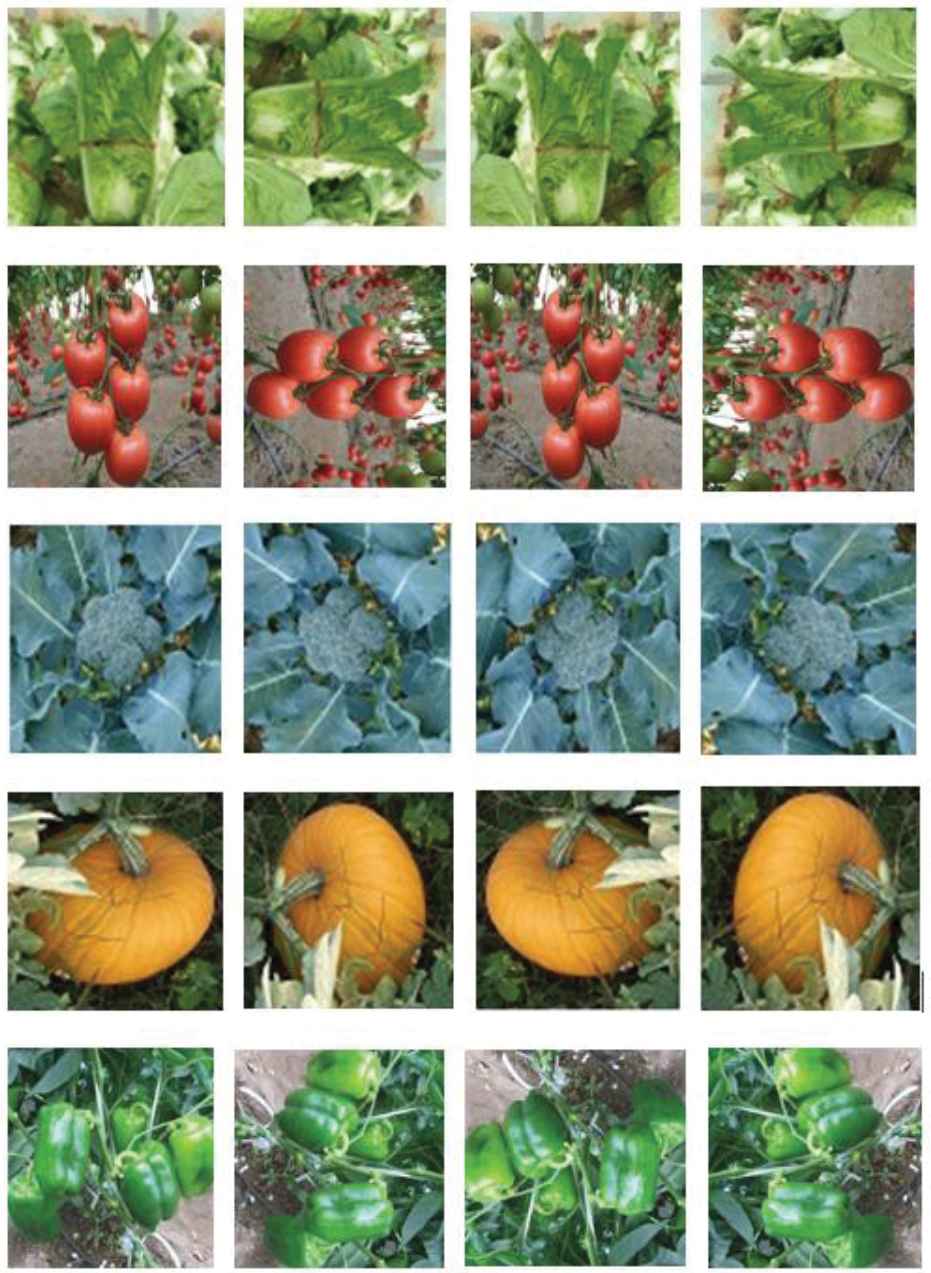
Part of the vegetable data expansion.
In Figure 1, each category of vegetables from left to right is the image of original, rotating 90°, 180° and 270°. Each image size is different in vegetable image data set, in order to neatly arrange the image, the image is processed into the same size in Figure 1 (80*80). The data expansion method is suitable for training and testing images. In the training phase, the increase data can produce additional training samples, thereby reducing the impact of overfitting. In the test phase, the increase in data helps to improve the classification accuracy rate.
3.2. Improvement of VGG Model
In order to improve the classification accuracy of vegetables in VGG-16 network, fusing fc6 (fully connected layer) and fc7 of network output features, we call the improved network VGG-M. The VGG-M network fused fc6 and fc7 layers with double dimensions, resulting the network convergence is slow when the model is trained. To solve this problem, five BN layers were added, and the network was called VGG-M-BN. The improved VGG network model and the traditional VGG network model are shown in Table 1.
| VGG-16 | VGG-M | VGG-M-BN |
|---|---|---|
| Input (224*224 RGB Image) | Input (224*224 RGB Image) | Input (224*224 RGB Image) |
| conv1-1-64 | conv1-1-64 | conv1-1-64 |
| conv1_2-64 | conv1_2-64 | Batch Normalization1 |
| pool1 | pool1 | conv1_2-64 |
| pool1 | ||
| conv2_1-128 | conv2_1-128 | conv2_1-128 |
| conv2_2-128 | conv2_2-128 | Batch Normalization1 |
| pool2 | pool2 | conv2_2-128 |
| pool2 | ||
| conv3_1-256 | conv3_1-256 | conv3_1-256 |
| conv3_2-256 | conv3_2-256 | Batch Normalization3 |
| conv3_3-256 | conv3_3-256 | conv3_2-256 |
| pool3 | pool3 | conv3_3-256 |
| pool3 | ||
| conv4_1-512 | conv4_1-512 | conv4_1-512 |
| conv4_2-512 | conv4_2-512 | Batch Normalization4 |
| conv4_3-512 | conv4_3-512 | conv4_2-512 |
| pool4 | pool4 | conv4_3-512 |
| pool4 | ||
| conv5_1-512 | conv5_1-512 | conv5_1-512 |
| conv5_2-512 | conv5_2-512 | Batch Normalization5 |
| conv5_3-512 | conv5_3-512 | conv5_2-512 |
| pool5 | pool5 | conv5_3-512 |
| Pool5 | ||
| Fc6 | Fc6 | Fc6 |
| Fc7 | Fc7 | Fc7 |
| Fc-1000 | Fc6,7 | Fc6,7 |
| Fc-10 | Fc-10 | |
| SoftMax | SoftMax | SoftMax |
Three kinds of network structure comparison.
In Table 1, VGG-M has 17 layers (except the input layer), there is one more fully connected layer than the traditional VGG-16 network. VGG-M has 22 layers (except the input layer), There are 13 convolutional layers, 5 BN layers (new), 4 fully connected layers (Fc6, 7 layer added) and SoftMax layer. The convolutional layer and the pooling layer appear alternately.
The main function of the convolutional layer is feature extraction, which use the 3*3 conv. layers throughout the whole net can decrease the number of parameters when compared to AlexNet model. The incorporation of 1*1 conv. layers can increase the nonlinearity of the decision function [23]. We will take garden pepper as an example, visualizing the output features of convolutional layers (only show the first 36) as shown in Figure 2.
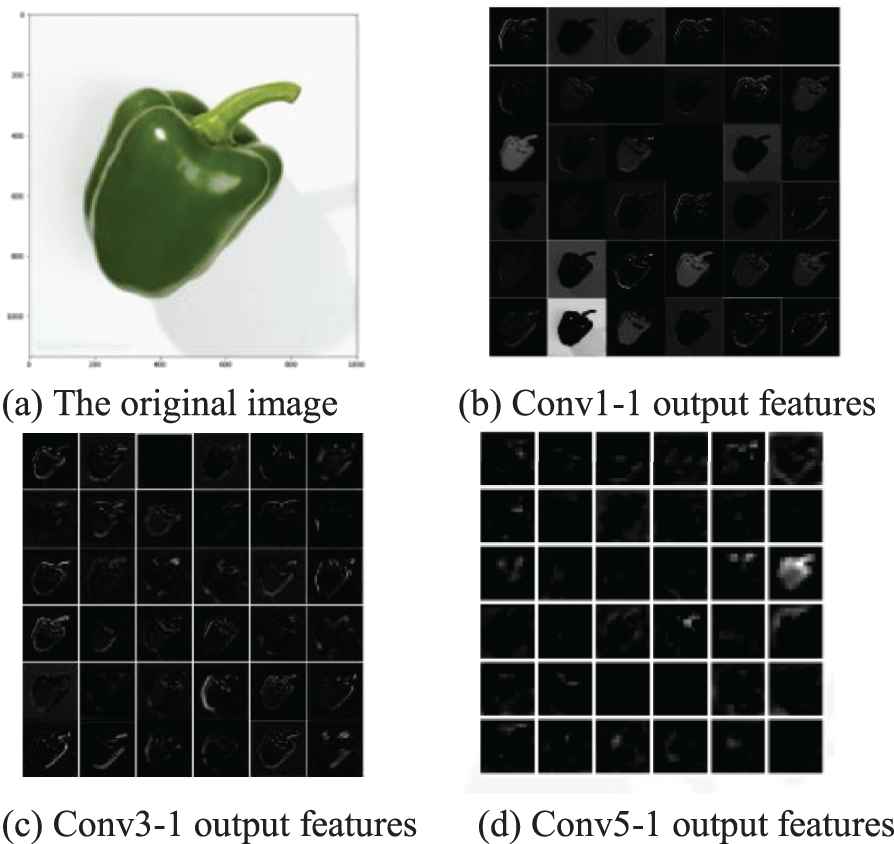
Output features of partially convolutional layers.
Figure 2 shows that the contour feature of the image near the input layer is clear and close to the shape of the original image. When the number of layers increases, the features gradually change into blur and abstract, it can be seen that the various layers of the model represent different levels of abstraction.
In this paper, the pooling layer using max pooling operation, this action seeking maximum value in each field, regardless of where is the maximum value in the region, the value of the Max pooling operation is the same. Therefore, the operation can realize translation, rotation and scale invariance, which provides a strong robustness for the model. The output features of the pooling layers are visualized, as shown in Figure 3.
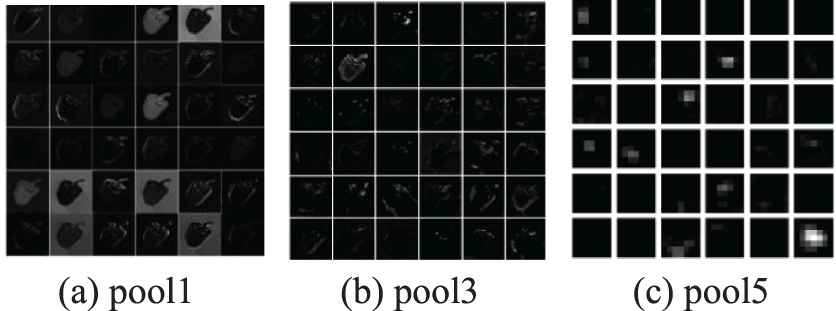
Output features of partially pooling layers.
The input of the pooling layer comes from the last convolutional layer, through max pooling operation, the number of network structure parameters is reduced while retaining the main features. Preventing the occurrence of the overfitting, it also improves the generalization ability of network.
The activation function of the VGG-M-BN network uses the Rectified Linear Units (ReLUs). The unsaturated nonlinear characteristics of the function is effective to alleviate the problem that the traditional Sigmoid and Tanh activation functions are easy to produce gradient disappear. Moreover, when using the ReLU function, the output does not tend to saturate as the input increases gradually, it can solve the problem of gradient disappearing. And when training, ReLU can speed up the network training.
The BN layer mainly solves the problem that the middle layer data distribution changes during the training process, to prevent the gradient from disappearing or exploding and speeding up network convergence. The specific BN operation is to normalize the activation value of each neuron in the hidden layer.
Among them, the calculation of
The calculation of
By training and learning parameters
The last of the fully connected layer is a SoftMax layer with 1000 outputs, according to the number of packets of the vegetable image data set, the number of output layer classification is changed from the original 1000 to 5. The traditional gradient descent method is used to train the parameters of the network. The whole learning process in the network gradually reduces the learning rate, to improve the learning speed of the initial network while ensuring that the model can make the loss function reliable convergence.
4. EXPERIMENTS AND DISCUSSION
Our experimental environment is used the operating system Windows10, Deep learning framework Caffe1, CUDA8.0, cuDNN5.1 and Python3.5, using GPU to calculate, the video card is GTX1080 and 8G memory.
In this paper, the vegetable image dataset was trained with the VGG-M-BN network. To verify the effect of batch_size on classification accuracy. Setting batch_size to 1, 2, 4 and 8, respectively.
In Table 2, we can find that the accuracy increases with the increase of batch_size. The larger the batch_size, the more accurate the reduction direction, the smaller the training shock, in the meanwhile, increased batch_size can improve memory utilization efficiency, and speed up processing. As can be seen from Figure 4, the batch_size setting not only has a great impact on accuracy, but also affects the convergence speed of the network. When batch_size is 8, the network converges fastest.
| Batch_size | 1 | 2 | 4 | 8 |
|---|---|---|---|---|
| Top1 accuracy (%) | 36.5 | 86.6 | 92.4 | 96.5 |
batch_size experimental results.
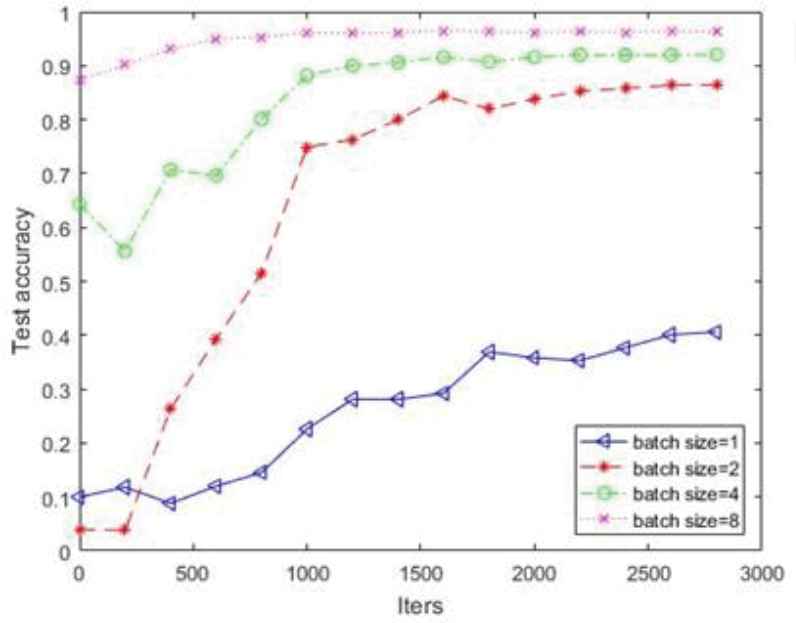
The accuracy of different batch_size.
The ReLU used in this paper is compared with the traditional Sigmoid and the Tanh function. The experimental results are shown in Table 3.
| Activation Function | Sigmoid | Tanhn | ReLU |
|---|---|---|---|
| Top1 accuracy (%) | 27.4 | 70.3 | 96.5 |
Legend: Bold indicates the highest accuracy rate in the comparison experiment results.
Activation function experiment results.
Table 3 shows the accuracy of ReLU activation function is significantly higher than that of traditional Sigmoid and Tanh function. Figure 5 is a graph of the Top1 accuracy with the change of iteration times when the VGG-M-BN network uses three activation functions respectively. We can see that the convergence rate of ReLU activation function is obviously faster than Sigmoid and Tanh function.
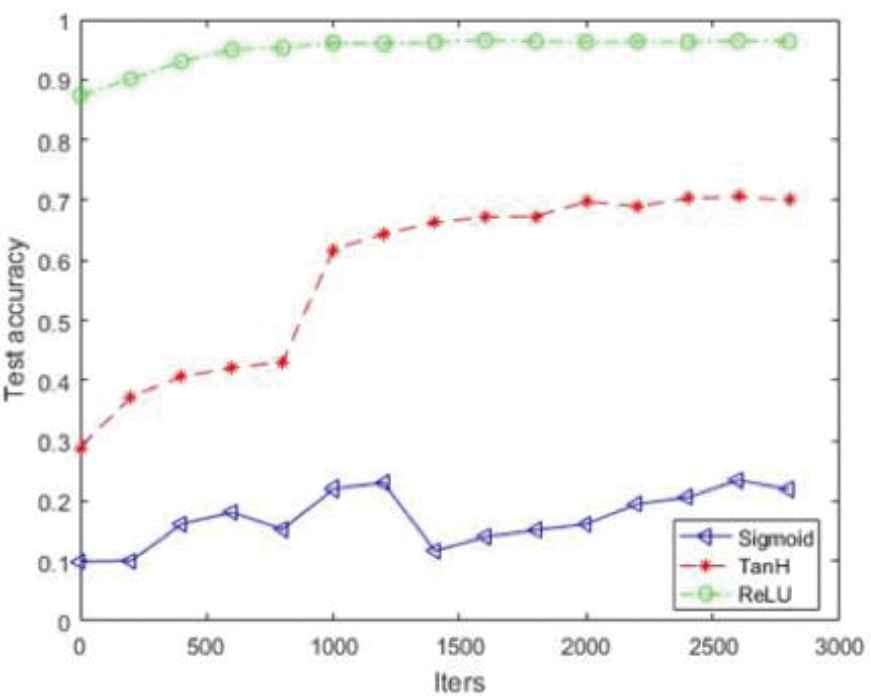
The accuracy of different activation functions.
In order to verify the relationship between the accuracy rate of vegetable image classification and the number of image data set, a total of 24000, 12000, 6000, 3000 and 1500 images were randomly selected and trained on the VGG-M-BN network from 48000 vegetable image data set. Among them, the training data set accounted for 80%, test data set accounted for 20%.
As we can see from Table 4, when the number of vegetable image data sets is decreasing, the accuracy of Top1 is decreasing. When the number of data sets was less than 6000, the accuracy of Top1 was less than 90%. The accuracy rate dropped by nearly 10 percentage points compared with the dataset of 48000. The experiment verifies that the number of image data sets can affect the accuracy of recognition and classification. The accuracy of different number of dataset is shown in Figure 6.
| Index | 48000 | 24000 | 12000 | 6000 | 3000 | 1500 |
|---|---|---|---|---|---|---|
| Top1 accuracy (%) | 96.5 | 94.1 | 92.5 | 90.4 | 88.5 | 84.4 |
Legend: Bold indicates the highest accuracy rate in the comparison experiment results.
Different number of experimental results.
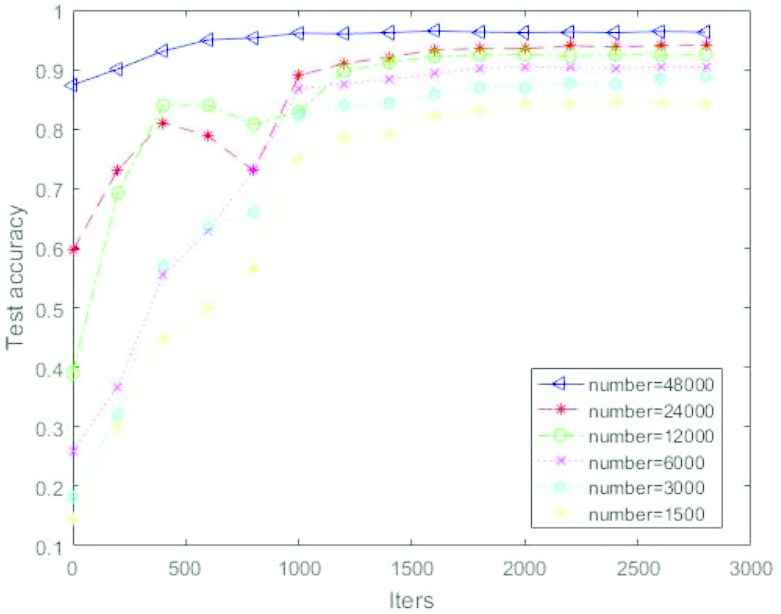
The accuracy of different number of dataset.
The experimental results of VGG-M, VGG-M-BN network and traditional VGG-16 and AlexNet networks are shown in Table 5 and the accuracy curve of Top-1 accuracy is shown in Figure 7.
| Index | AlexNet | VGG | VGG-M | VGG-M-BN |
|---|---|---|---|---|
| Top1 accuracy (%) | 86.3 | 92.1 | 95.8 | 96.5 |
Legend: Bold indicates the highest accuracy rate in the comparison experiment results.
Comparison of network experiment results.
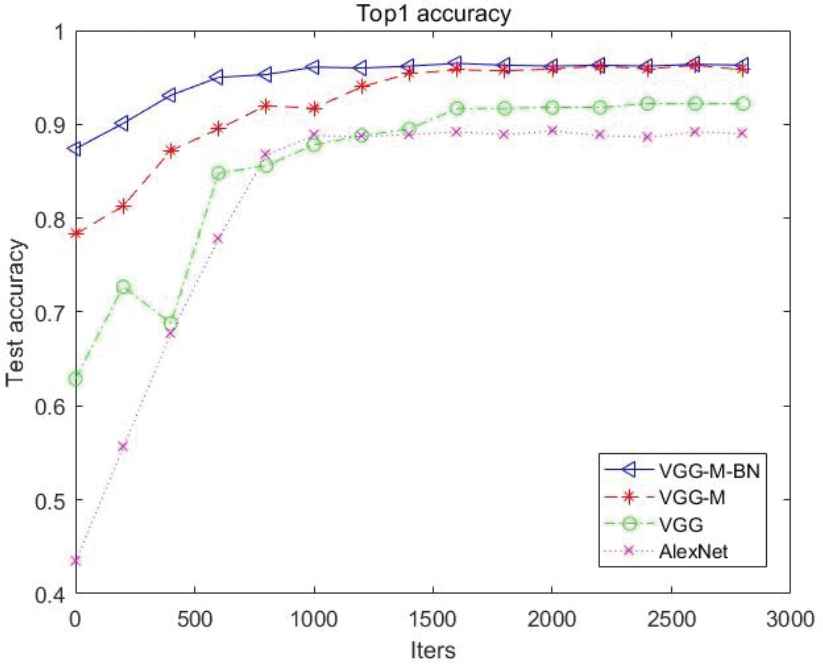
Top1 accuracy.
In Table 5, The Top1 accuracy of VGG-M and VGG-M-BN network is about 10 % higher than that of traditional AlexNet and VGG network. Although the accuracy of VGG-M network is improved, the convergence rate of the network is slow, in order to solve this problem, the BN layer was added to the VGG-M network.
As can be seen from Figure 7, VGG-M iterated 1500 times, and the network converges. While the VGG-M-BN network has converged at 500 iterations. After increasing the BN layer, the convergence rate is improved. Moreover, the convergence speed of the VGG-M-BN network is faster than that of the traditional VGG and AlexNet networks. Experimental results verify the effectiveness of the proposed method.
5. CONCLUSION
In order to improve the accuracy of recognition and classification of vegetables, based on the improved VGG network model, this paper proposes a target recognition and classification method. The main contributions include: Self-built ten kinds of vegetable image data sets. The images were obtained from the image database of ImageNet, website crawler and shoot by myself. The image data extension method is used to reduce overfitting in the learning process. At the same time, the image is pretreated and normalized. In this paper, the recognition and classification methods of vegetable images of VGG-M and VGG-M-BN are presented. On the basis of the traditional VGG network, VGG-M combines the output features of the first two fully connected layers, the accuracy was 95.8%. The accuracy of VGG-M-BN network after adding BN layer reached 96.5%, in the meanwhile, the convergence rate of the network has accelerated. This paper is also verified the influence of the number of data sets, the size of batch_size and the different activation functions on the recognition and classification accuracy.
Although the recognition and classification of vegetable image data set has achieved some results, compared with the traditional AlexNet and VGG network Top1 accuracy has improved, but there are still deficiencies can be improved from the following aspects:
Improving vegetable image data set. There are fewer kinds of vegetables used in this paper, the variety of vegetables can be added on this basis, to make it contain all the vegetables we see everyday.
Adopt ensemble learning methods. On the basis of this paper, ensemble learning methods can be used, combining the characteristics and advantages of different models to improve the accuracy of recognition and classification of vegetable images.
CONFLICT OF INTEREST
No conflict of interest has been declared by the authors.
AUTHORS' CONTRIBUTIONS
Zhenbo Li: contributed to the conception of the study; Ling Zhu: performed the experiment and performed the data analyses and wrote the manuscript; Fei Li: contributed significantly to analysis and manuscript preparation; Jun Yue: helped perform the analysis with constructive discussions.
ACKNOWLEDGMENTS
This work was supported by the Hebei Province School Science and Technology Cooperation Development Fund Project (Grant No. 18047405D, Grant No. 201805510811480), the International Science and Technology Cooperation Program of China (Grant No. 2015DFA00530), and the Key Research and Development Plan Project of Shandong Province (Grant No. 2016CYJS03A02).
Footnotes
REFERENCES
Cite this article
TY - JOUR AU - Zhenbo Li AU - Fei Li AU - Ling Zhu AU - Jun Yue PY - 2020 DA - 2020/06/02 TI - Vegetable Recognition and Classification Based on Improved VGG Deep Learning Network Model JO - International Journal of Computational Intelligence Systems SP - 559 EP - 564 VL - 13 IS - 1 SN - 1875-6883 UR - https://doi.org/10.2991/ijcis.d.200425.001 DO - 10.2991/ijcis.d.200425.001 ID - Li2020 ER -
